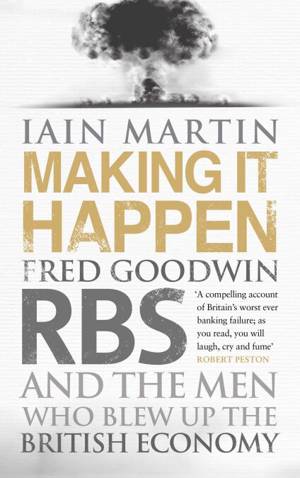
- Afhalen na 1 uur in een winkel met voorraad
- Gratis thuislevering in België vanaf € 30
- Ruim aanbod met 7 miljoen producten
- Afhalen na 1 uur in een winkel met voorraad
- Gratis thuislevering in België vanaf € 30
- Ruim aanbod met 7 miljoen producten
Zoeken
Making It Happen E-BOOK
Fred Goodwin, RBS and the men who blew up the British economy
Iain Martin
E-book | Engels
€ 10,20
+ 10 punten
Omschrijving
When RBS collapsed and had to be bailed out by the taxpayer in the financial crisis of October 2008 it played a leading role in tipping Britain into its deepest economic downturn in seven decades. The economy shrank, bank lending froze, hundreds of thousands lost their jobs, living standards are still falling and Britons will be paying higher taxes for decades to pay the clean-up bill.
How on earth had a small Scottish bank grown so quickly to become a global financial giant that could do such immense damage when it collapsed?
At the centre of the story was Fred Goodwin, the former chief executive known as "Fred the Shred" who terrorised some of his staff and beguiled others. Not a banker by training, he nonetheless was given control of RBS and set about trying to make it one of the biggest brands in the world. It was said confidently that computerisation and new banking products had made the world safer. Only they hadn't...
Based on more than 80 interviews and with access to diaries and papers kept by those at the heart of the meltdown, this is the definitive account of the RBS disaster, a disaster which still casts such a shadow over our economy. In Making It Happen, senior executives, board members, Treasury insiders and regulators reveal how the bank's mania for expansion led it to take enormous risks its leaders didn't understand.
From the birth of the Royal Bank in 18th century Scotland, to the manic expansion under Fred Goodwin in the middle of a mad boom and culminating in the epoch-defining collapse, Making It Happen is the full, extraordinary story.
How on earth had a small Scottish bank grown so quickly to become a global financial giant that could do such immense damage when it collapsed?
At the centre of the story was Fred Goodwin, the former chief executive known as "Fred the Shred" who terrorised some of his staff and beguiled others. Not a banker by training, he nonetheless was given control of RBS and set about trying to make it one of the biggest brands in the world. It was said confidently that computerisation and new banking products had made the world safer. Only they hadn't...
Based on more than 80 interviews and with access to diaries and papers kept by those at the heart of the meltdown, this is the definitive account of the RBS disaster, a disaster which still casts such a shadow over our economy. In Making It Happen, senior executives, board members, Treasury insiders and regulators reveal how the bank's mania for expansion led it to take enormous risks its leaders didn't understand.
From the birth of the Royal Bank in 18th century Scotland, to the manic expansion under Fred Goodwin in the middle of a mad boom and culminating in the epoch-defining collapse, Making It Happen is the full, extraordinary story.
Specificaties
Betrokkenen
- Auteur(s):
- Uitgeverij:
Inhoud
- Aantal bladzijden:
- 352
- Taal:
- Engels
Eigenschappen
- Productcode (EAN):
- 9781471113567
- Verschijningsdatum:
- 11/09/2013
- Uitvoering:
- E-book
- Beveiligd met:
- Adobe DRM
- Formaat:
- ePub

Alleen bij Standaard Boekhandel
+ 10 punten op je klantenkaart van Standaard Boekhandel
Beoordelingen
We publiceren alleen reviews die voldoen aan de voorwaarden voor reviews. Bekijk onze voorwaarden voor reviews.











